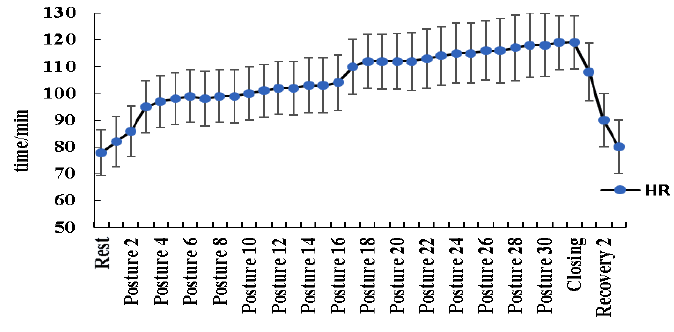Measurement and Evaluation of Energy Metabolism of Bafa-Wubu Tai Chi
Keywords:
taijiquan, BaFa Wubu, Taichi, Tai chi, Energy metabolism, Exercise physiology, RespirationAbstract
AbstractBackground
The Bafa Wubu of Tai Chi (Eight Elements and Five Steps) is a novel tai chi form recently developed with the General Administration of Sport of China in order to promote Tai Chi in China and abroad. While this form has already been taught to thousands, no studies have been previously reported on its exercise physiology.
Objectives
To reveal the characteristics of respiration and energy metabolism of the Bafa Wubu of Tai Chi and lay a theoretical foundation for further scientific research on Tai Chi practice.
Methods
First, the baseline maximal exercise capacity of all the participants was measured. Then they received Bafa Wubu of Tai Chi training for three weeks to ensure that they gained proficiency. All participants then performed a single iteration of the Bafa Wubu Tai Chi form while their energy metabolism was measured dynamically, including maximal oxygen uptake (VO2max), oxygen uptake/kg (VO2/kg), metabolic equivalent (METs), heart rate (HR), respiratory quotient (RQ), tidal volume(TV), respiratory frequency, blood pressure, oxygen saturation and rate of perceived exertion (RPE).
Results
106 healthy individuals were recruited. After the 3-week practice, 100 (94%) individuals passed the assessment and were invited to participate in the physiologic testing. Prior to completing the study, 5 (5%) subjects withdrew. The 95 subjects who completed the study consisted of 63 men (aged 39.7 years±9.8) and 32 women (aged 36.9 years±11.1).
A single iteration of the Bafa Wubu Tai Chi form required approximately 3 minutes. During practice of Tai Chi, the average VO2 for men was 0.72±0.16 (L/min), which was 26.17% ±6.77% of VO2max; the average VO2 for women was 0.67±0.19 (L/min), which was 30.25%±5.76% of VO2max. Immediately after Bafa Wubu of Tai Chi exercise, SP increased by 17.3% (p<0.01) ; HR increased by 53.2% (p<0.01); and RPE increased by 76.4% (p<0.01); but there were no significant differences in DP and SpO2, P=0.489, P=0.312. (3) The average METs was 2.21±0.44 METs, the average VO2/kg was 13.81 ±4.24 ml/kg/min, the average HR was 104±16times /min, the average RQ was 0.80±0.08, the average respiratory frequency was 24 ±4 times / min; The average TV was 0.83 ±0.21L.
Conclusion
The Bafa Wubu of Tai Chi is a low intensity aerobic exercise, and energy consumption is mainly from the oxidation of fat. The Bafa Wubu of Tai Chi improves cardiopulmonary function demonstrated by improvement of pulmonary ventilatory function through increase of tidal volume during exercise.

Published
How to Cite
Issue
Section
Copyright (c) 2020 Shaojun Lyu, Jianwei Zhang, Wen Yuan, Zaihao Chen, Tianming Gao, Yameng Li, Cuihan Li, Bo Song, Hongwei Wang, Meize Cui, Qiuyang Wei

This work is licensed under a Creative Commons Attribution-NonCommercial-NoDerivatives 4.0 International License.

